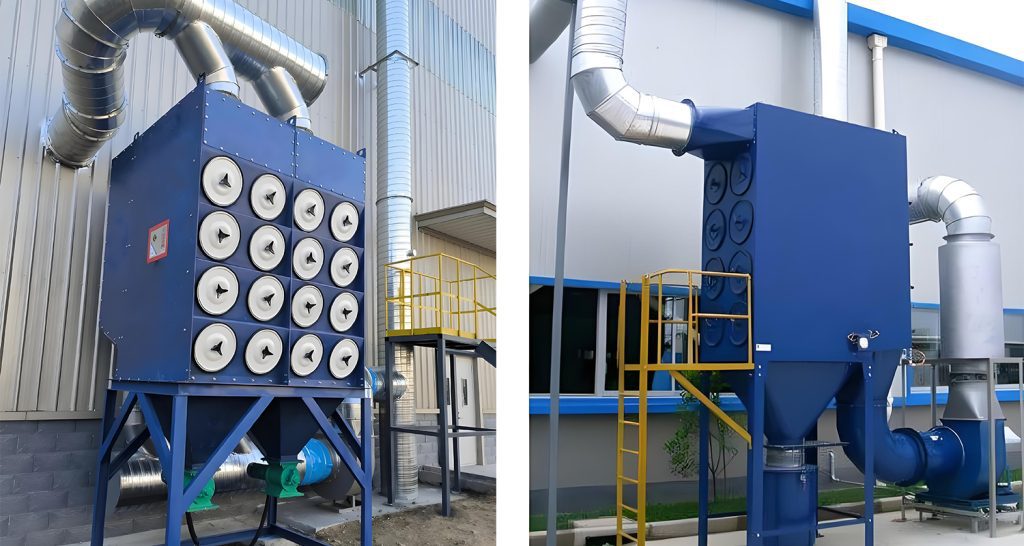Dust emissions in steel production account for over 15% of industrial particulate pollution. With stricter environmental regulations, traditional baghouses often fail to meet efficiency standards. Cartridge dust collectors offer a compact, high-performance alternative—but their success depends on correct application. This guide explores how steel plants can leverage cartridge technology while avoiding common pitfalls.
1. Working Principle and Characteristics of Cartridge Dust Collectors
1.1 How Cartridge Dust Collectors Work
Cartridge dust collectors use cartridges as the filtering element and employ pulse jet technology for dust removal. The working principle involves dusty air being sucked into the housing through the dust hood, ducts, and air inlet. As the air flow suddenly expands and interacts with the air distribution plate, larger dust particles fall directly into the dust hopper due to gravity and inertia. Smaller and lighter particles pass through the cartridge, where they are captured by the filter material through Brownian diffusion and sieving effects. After backflushing, the dust falls into the dust bin for recycling, while clean air is discharged through the exhaust pipe with the help of a fan.
1.2 Key Advantages
► OSHA-Compliant Filtration Efficiency:The cartridges use imported polyester fibers as filter media. They feature a layer of ultra-thin sub-micron fibers that effectively block most sub-micron dust particles, achieving a filtration efficiency of up to 99.99%, meeting ultra-low emission standards.
► Low-Resistance Design: Thanks to the large filtration area and low filtration velocity, the operating resistance typically does not exceed 1000 Pa. This reduces the operational load and costs of the dust collection system.
►Compact Structure: The design of the cartridges occupies minimal space, making installation and replacement easier. Cartridges are generally shorter than bag filters, simplifying construction and maintenance.
►Long Service Life: The cartridges use imported polyester fibers , achieving 99.99% sub-micron filtration – meeting strict steel plant emission standards.
►Reusable: Polyester cartridges and membrane-covered cartridges can usually be washed with water and reused, lowering procurement costs.
1.3 Limitations to Consider
⚠️ Not for High-Moisture Applications :In humid environments, cartridges can become blocked, requiring downtime for replacements, which affects production efficiency.
⚠️ Higher Cost vs Baghouse Filters: The unit price of the filter cartridge is 5-8 times that of a standard cloth bag, but the overall service life is better.
2. Steel Production Dust Characteristics
Critical Data for Dust Collector Selection:
| Production Area | Particle Size Distribution | Moisture Content | Temp Range |
|---|---|---|---|
| Sintering Material | N/A | >6% | 50-80°C |
| Blast Furnace | 76-84% below 200 mesh | <1% | 100-150°C |
| BOF Steelmaking | >5μm (98%) | 1.0-1.5% | 80-120°C |
2.1 Sintering Raw Material Area
Due to transportation issues, both domestic and foreign ores generally have a moisture content above 6%. The use of enclosed storage sheds and spray dust suppression further exacerbates dust emissions.
2.2 Sintered Product and Ore Bin Area
1.Sintered products generate dust particles ranging from 0.8 to 61.0 μm during transport, with moisture content below 1%.
2.Blast furnaces commonly use heated grinding techniques, with particles below 200 mesh comprising 76% to 84%, and moisture content also below 1%.
3.During coke transportation, the moisture content is below 1% for dry quenching processes, while wet quenching processes often exceed 10%.
2.3 Converter Steelmaking Area
1.Fluxes used in converters typically have a moisture content of 1.0% to 1.5%.
2.Dust generated during the steelmaking process has over 98% of particles larger than 5 μm, with low temperatures.
3.The moisture content of dust from converter slag handling often exceeds 10%.
2.4 Rolling Steel Production Area
Wet gas emissions during rolling processes usually exceed 10% humidity, primarily due to water cooling.
2.5 Coking Production Area
1.Coal dust generated during the coking preparation area often has a moisture content above 6%, with over 99% of particles larger than 2 μm.
2.The dust particle size during coal pushing generally ranges from 3.3 to 4.7 μm, with waste gas humidity between 1% and 5%.
2.6 Flux Production Area
During the transport of limestone and finished lime, over 95% of dust particles exceed 10 μm, with moisture content below 1%.

3. Key Recommendations for Cartridge Dust Collector Applications in Steel Plants
① Moisture Control Strategies
Avoid collecting high-humidity waste gas: This includes waste gas from iron ore in the sintering preparation stage and from wet coking processes.
For OSHA-compliant dust control, monitor humidity levels at material transfer points.
② Handling Sticky Particulates
Use caution with sticky waste gas: This applies to dust generated during lime transport and in the coking process.
Note: Sticky dust with >5% moisture content may require pre-treatment.
③ Airflow Optimization
Optimize inlet design: Lower the inlet airspeed of the cartridge dust collector and improve internal airflow distribution to ensure uniform flow among cartridges.
Recommended inlet velocity: ≤1.2 m/s for most steel applications.
④ Pulse Jet System Maintenance
Ensure uniform backflushing airflow: The length of the backflushing nozzle should be maximized to maintain even airflow distribution.
Best practice: Inspect nozzle alignment quarterly.
⑤ Quality Assurance Protocols
Strictly control cartridge quality: Ensure that the technical parameters of folded cartridges meet relevant standards. Inspect the quality of the membrane and uniformity of folds, and verify the manufacturing process of the cartridge seals.
Certification: Look for ISO 16890 compliant filters.
In conclusion, cartridge dust collectors hold significant promise for use in steel enterprises. However, optimizing design and usage strategies based on specific operating conditions is essential to enhance dust removal efficiency and cost-effectiveness. Choose Darko’s cartridge dust collectors for outstanding performance and reliable solutions.
For more information about our products or to seek professional advice, please feel free to contact us!

